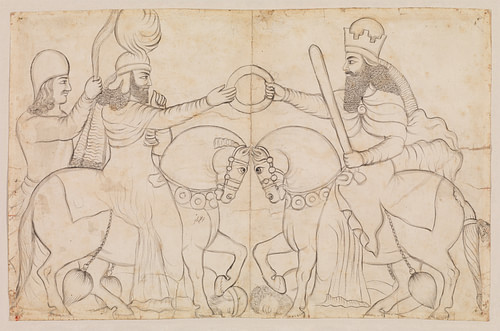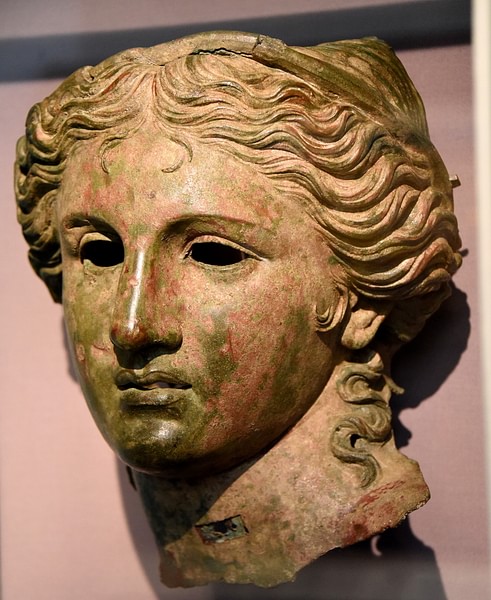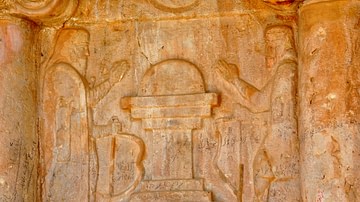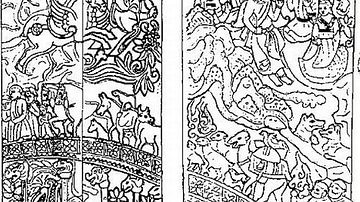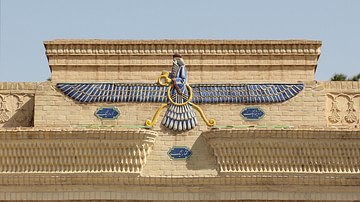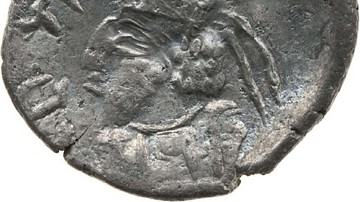Ancient Persian Mythology is the term now referencing ancient Iranian religion prior to the rise of Zoroastrianism between c. 1500-1000 BCE. This was a polytheistic faith with a pantheon led by the supreme god Ahura Mazda (“Lord of Wisdom”), champion of order, against the dark forces of Angra Mainyu (“Destructive Spirit”) and his legions of chaos.
As with other ancient polytheistic faiths, the gods of the Early Iranian Religion each had their own field of expertise they presided over and to whom one would pray for specific needs. In the present day, one would not go to one's dentist and ask they fix one's car, care for one's children, improve one's marriage, or make one's crops grow; one would consult a mechanic, a childcare professional, marriage counselor, and agricultural specialist.
This was the paradigm of all ancient polytheistic faiths and why the people who believed in polytheistic belief systems would have considered the concept of monotheism absurd (as exemplified by the later reaction against Akhenaten's efforts to install monotheism in Egypt during his reign of 1353-1336 BCE). No one god, it was thought, could attend to so many different people's various needs.
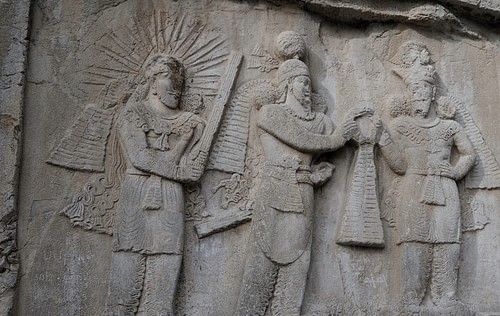
Even so, between c. 1500-1000 BCE, Zoroaster conceived of a new vision in which one Supreme Deity – Ahura Mazda – could do so and, according to this revelation, had always done so; people had simply been mistaken in thinking there were many gods when there had always only been one. After Zoroaster's vision, the pantheon of deities was demoted to emanations of Ahura Mazda. One could still pray to a figure such as Anahita for help in conception but would do so in the knowledge that this was not an actual goddess but simply an aspect of Ahura Mazda.
Twelve of these “emanations” – the most prominent of the old gods - were retained by the new religion. Ahura Mazda became the Supreme God of Zoroastrianism and Angra Mainyu his opponent. Anahita and Mithra would continue as powerful representations of Ahura Mazda's creative and protective aspects and Atar as a symbol of the god himself while Zorvan – once a minor god of time – would become the Supreme God of Zorvanism under the Sassanian Empire (224-651 CE). Other gods and spirits would also be reimagined beyond the definition of mythology and exert their own influences. The twelve most prominent of the ancient Iranian pantheon were:
- Ahura Mazda – King of the Gods
- Angra Mainyu – Principle of Evil, Chaos, and Discord
- Mithra – God of the rising sun, covenants, contracts, and kingship
- Hvar Ksata – God of the full sun
- Ardvi Sura Anahita – Goddess of fertility, health, water, wisdom, war
- Rashnu – An angel; the righteous judge of the dead
- Verethragna – Warrior god who fights against evil
- Tiri and Tishtrya – Gods of agriculture and rainfall
- Atar – God of the divine element of fire; personification of fire
- Haoma – God of the harvest, health, strength, vitality; personification of the plant of the same name whose juices brought enlightenment
- Vayu – God of the wind who chases away evil spirits
- Zorvan (Zurvan Akarana) – God of time, personification of Infinite Time
These entities exerted significant influence prior to Zoroaster's reformation and, in a number of cases, continued to do so. They are considered “mythological” in the present day only because the accepted paradigm of divinity is now monotheistic but, in their time, they were as real to the people as any god is to any modern-day religious adherent.
Ahura Mazda
The king of the gods, Ahura Mazda (also known as Ormuzd) created all things. He first created sky, then water, earth, vegetation, animals, human beings, and fire. After he had fashioned sky, water, and earth, and covered earth with plants and flowers, he made the Primordial Bull Gavaevodata who was so beautiful it attracted the attention of Angra Mainyu who killed it. Ahura Mazda brought the body of the androgynous bull to the moon where it was purified and, from its purified seed, came all other animals. Ahura Mazda then made the first human, Gayomoartan, who was also killed by Angra Mainyu. From his purified seed came the first mortal couple – Mashya and Mashyanag – who lived in bliss until corrupted by Angra Mainyu's lies. They then lost paradise, but their descendants inherited the gift Ahura Mazda had given them of free will and so could choose for themselves whether to follow good or embrace evil. Ahura Mazda stood for all that was ennobling and righteous and encouraged people to be the best version of themselves.
Angra Mainyu
The spirit of discord, Angra Mainyu (also known as Ahriman) led the legions of dark spirits known as the daevas. His sole purpose was to disrupt the order established by Ahura Mazda and he would destroy whatever beauty Ahura Mazda had created – as in the cases cited above. His origin in Early Iranian Religion is never given but later work by the Orientalist Martin Haug (l. 1827-1876 CE) describes him as the “destructive emanations” from Ahura Mazda's creative act. In the same way that other deities became “emanations”, so was Angra Mainyu only this spirit was the excess dross of creation which became sentient and malevolent toward the creation. In the later religious belief system of Zorvanism, Angra Mainyu and Ahura Mazda are twin brothers born of the god Akarana Zorvan (“Infinite Time”) and are equal in power.
Mithra
The best-known and most popular god of the Early Iranian pantheon. Mithra was the god of the rising sun, contracts, covenants, friendship, and was responsible for the orderly change of seasons and cosmic order. As an agent of enlightenment, he was associated with the haoma plant and the god Haoma. He was also protector of the faithful and guide toward asha (truth) and the most powerful warrior against the forces of darkness. He is depicted as riding in a chariot drawn by white horses, armed with a silver spear, a bow and arrows of gold, daggers, axes, and his famous mace, the most formidable of his weaponry. As the god who controlled cosmic order, he was responsible for the protection and dispensation of the farr (“divine grace”) which legitimized a king's rule. Mithra granted a monarch the right to rule and, when the king violated the contract by unrighteous behavior, the divine grace was withdrawn and given to another found worthier.
Mithra is best known from the Roman mystery religion, the Cult of Mithras, which, though no doubt influenced by the Roman army's association with Persian religion on their campaigns, is a distinct belief system having nothing, finally, to do with Persian/Iranian worship of Mithra pre-Zoroaster. The Mithras of the Roman cult is considered an astrological deity developed by Roman sensibilities and of a wholly different character than the Persian Mithra.
Hvar Ksata
Also given as Hvare-Khshaeta, the god of the sun whose name translates as “radiant sun”. He was considered the deity of the full sun whereas Mithra was god of the rising sun. The sun was also seen as Hvar Ksata himself. He was among the most popular and widely venerated gods of the early pantheon along with his counterpart Mangha (better known as Mah), goddess of the moon. As god of the sun, and the sun itself, Hvar Ksata was responsible for life on earth through the flourishing of crops. Even after he was overshadowed by Mithra, who eventually took on his role as a sun god, he continued to be honored and was associated with the divine grace legitimizing kingship.
Ardvi Sura Anahita
One of the most popular and enduring deities of the pantheon, Anahita is the goddess of fertility, water, health and healing, and wisdom. Her association with life and health also linked her with war and death as warriors would pray to her for victory and survival before battle; she is therefore sometimes referenced as a goddess of war. Anahita is depicted as a beautiful woman wearing a white gown embroidered with gold, golden earrings and necklace, and a gold crown, carrying the consecrated barsom twigs of life in one hand (initially, possibly, stalks of the haoma plant, and so linking Anahita with the god Haoma). She rides in a chariot drawn by the four horses of wind, rain, cloud, and sleet, linking her with the weather through her association with fertility. She was considered the source of all life on earth which was then nurtured and maintained by Hvar Ksata.
Rashnu
An angel, not a god, Rashnu was the righteous judge of the dead who stood on the Chinvat Bridge (the span between the world of the living and the dead), read the record of a soul's deeds in life, and sent them either to the paradise of the House of Song or the hell of the House of Lies. Rashnu was assisted in his duties by the angel Suroosh and the Holy Maiden Daena, both of whom represented the conscience of the deceased while also serving to comfort and protect the newly arrived soul. Rashnu would receive the record of a person's life from two other angels who had worked to compile it in the three days after that person's death when the soul lingered near the body. When his decision was given, it was understood as just and the soul moved on to its home in the afterlife. In later times, but before Zoroaster, Rashnu seems to have been replaced by Mithra as judge of the dead and a pair of scales were then used instead of a scroll of the person's deeds.
Verethragna
The warrior-god who fights against the forces of evil constantly. He has no other responsibilities and so is considered the greatest protection against the demons of Angra Mainyu. He is depicted in various forms and changes shape depending on the circumstances of battle. He can be a bull with yellow ears and golden horns, a white horse adorned with gold, a strong camel, a mighty boar, a young man of strength at the age of 15 (considered the ideal age when a boy became a man), a great ram, a deer, a warrior with a golden sword, a strong wind, or a great bird. As a bird, Verethragna was associated with Simurgh, the legendary bird of the mountains, whose feathers could be rubbed or burned to invoke her aid in times of need.
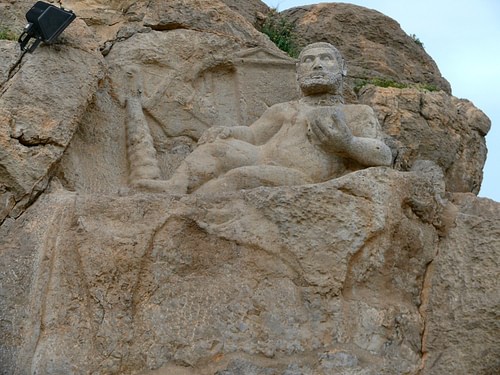
Tiri & Tishtrya
Tishtrya was the god of rains and the harvest who is sometimes given a twin, Tiri, god of agriculture. Tiri is not well attested and was most likely another name for Tishtrya although it is possible he was an earlier god who was later combined with Tishtrya. Tishtrya is depicted as a white horse with golden ears and ornamented with gold trappings who races across the sky and dives to earth, even under the sea, to do battle against the evil witch Duzhyairya (symbolizing bad harvest), and the demon Apaosha (drought). He is often represented as rising from the Vourukasha Sea, the source of all waters, rising into the air to find and do battle with his enemies. His strength is dependent on the proper worship given by the people. If humans did not perform the correct rites with the appropriate spirit, Tishtrya would weaken, the forces of darkness would prevail, and drought and bad harvest would follow.
Atar
Atar was the god of fire and the element itself, son of Ahura Mazda. He is depicted as flame and follows behind Mithra's chariot in battle. Fire was considered the presence of Atar himself in rituals and, after the rise of Zoroastrianism, the presence of Ahura Mazda. He is closely associated with Mithra (as he is with the Vedic deity Agni) and is the decisive factor in their battle with the dragon Azhi Dahaka who had stolen the Divine Grace. Atar corners and threatens the dragon, scaring it into releasing the Divine Grace to the heroes. Sacrifices of meat were made to Atar which were given by supplicants while they held the barsom twigs in their hand, a certain number required for specific rituals. The barsom twigs represented the earth and honored the Creator through the creation. It is thought these twigs were initially stalks of the haoma plant, thus linking Atar with the god Haoma.
Haoma
Haoma was the god of the harvest, health, strength, and vitality and the power which gave the plant of the same name its potency. He was associated with Anahita, Mithra, and Atar. People prayed to Haoma for strong sons, and the haoma plant is said to have been instrumental in Zoroaster's conception as his father mixed the haoma with milk which he and his wife drank prior to sex. The plant is thought to be of the genus ephedra (though this is contested) and was pressed for its juice which was then consumed to produce an altered, elevated, state of consciousness in which one could clearly apprehend the divine. In this state, one had increased strength, vitality, and vision which were gifts of Haoma as was an abundant harvest. Haoma does not seem to have been worshipped in a specific ritual but rather participated in any ritual in which the haoma plant's juices were utilized.
Vayu
Also given as Vayu-Vatu, he was the god of the wind who lived between the realms of Ahura Mazda and Angra Mainyu and, as such, could be either good or evil. Vayu was considered a yazata (spirit worthy of worship) or daeva (evil spirit), literally depending on which way the wind blew. He is depicted as a fierce warrior with golden weapons and an exceptionally sharp spear who races against the forces of darkness, scattering them, to maintain order but can also wheel about and become as formidable an opponent of the forces of light. In the later religion of Zorvanism, Vayu-Vatu came to be associated with earthly space and time within the vastness of Infinite Space and Infinite Time.
Zorvan
Zorvan (also given as Zurvan) was a minor god of time in the early belief system who later became known as Zorvan Akarana, god of Infinite Time. Initially, Zorvan seems to have represented the time and the space in which religious rituals were performed but at some point in the latter part of the Achaemenid Empire (c. 550-330 BCE), he developed into the supreme deity, the personification of Time, who gave birth to the twins Ahura Mazda and Angra Mainyu who were equal power. By the time of the Sassanian Empire, the Zorvanist movement was fully developed. It is thought this belief grew in response to the need for an answer to the question on the origin of evil. If Ahura Mazda was the supreme uncreated being, from whom all creation came, and was all-good, where did evil come from? Zorvanism answered this by making Time the supreme deity and Ahura Mazda a created being among many others.
Conclusion
The myths of the Early Iranian Religion, as with those of any ancient civilization, explained how the world worked, why the rains fell at certain times and not others, how the seasons changed, and why bad things happened to good people, among other phenomena. The Scottish anthropologist-folklorist James G. Frazer (l. 1854-1941 CE), observes, in his work The Golden Bough (1890 CE), that ancient people were naturally concerned with the forces which could do them the most harm – those that brought drought, flood, fire, infant mortality - and so imagined the dark and dangerous gods first and sought to placate these through certain rituals and sacrifice. This, he claims, is evident in the development of mythological characters such as Erra, the destructive force in Mesopotamian mythology, or the similar character of Set in ancient Egyptian religion.
This belief, Frazer continues, eventually gave rise to the creation of benevolent deities who responded in a similar fashion to sacrifice and worship. These gods would now take on the protective duties formerly the responsibility of the people through their rituals; now the rites were dedicated to the gods who controlled weather and people's fates and minimized the threats of the darker forces.
Whether this paradigm held true for the development of Early Iranian Religion is unknown but the system as it existed prior to Zoroaster seems to have gone in a different direction (if one even accepts Frazer's theory) in that the benevolent gods, all fully developed, were imagined first and those representing evil and discord later. There is no fully developed character in the belief system which became ancient Persian mythology comparable to Erra or Set or even Eris from Greece – all of whom represented chaos and disorder – as Angra Mainyu is simply the embodiment of evil and destruction. Detailed development of the origin and character of evil does not seem to appear until long after Zoroastrianism is fully established.
It could certainly be that there were fully developed myths concerning Angra Mainyu and his legions which have simply not survived. The Persians did not commit their early religious vision to writing and all that is known of the gods comes from later Zoroastrian works written in the Sassanian Period or even later works of literature and lore such as the Shahnameh or the One Thousand Nights and a Night. It could be, though, that the Persian vision focused early on the most admirable qualities, symbolized by the benevolent gods, knowing that, finally, the darker forces were irrelevant as they would ultimately be conquered by goodness and justice.
